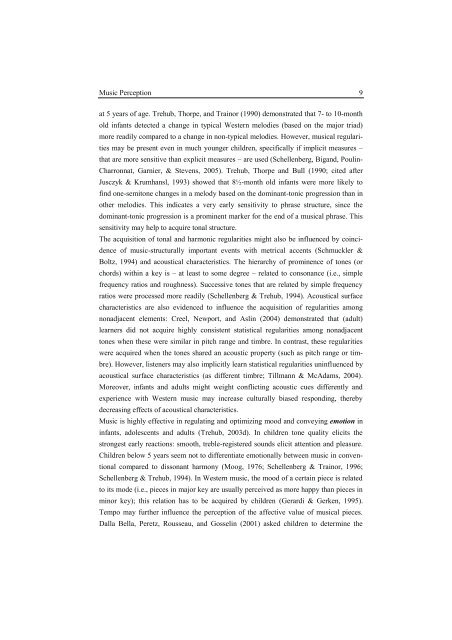Neural Correlates of Processing Syntax in Music and ... - PubMan
Neural Correlates of Processing Syntax in Music and ... - PubMan
Neural Correlates of Processing Syntax in Music and ... - PubMan
Create successful ePaper yourself
Turn your PDF publications into a flip-book with our unique Google optimized e-Paper software.
<strong>Music</strong> Perception 9<br />
at 5 years <strong>of</strong> age. Trehub, Thorpe, <strong>and</strong> Tra<strong>in</strong>or (1990) demonstrated that 7- to 10-month<br />
old <strong>in</strong>fants detected a change <strong>in</strong> typical Western melodies (based on the major triad)<br />
more readily compared to a change <strong>in</strong> non-typical melodies. However, musical regularities<br />
may be present even <strong>in</strong> much younger children, specifically if implicit measures –<br />
that are more sensitive than explicit measures – are used (Schellenberg, Big<strong>and</strong>, Poul<strong>in</strong>-<br />
Charronnat, Garnier, & Stevens, 2005). Trehub, Thorpe <strong>and</strong> Bull (1990; cited after<br />
Jusczyk & Krumhansl, 1993) showed that 8½-month old <strong>in</strong>fants were more likely to<br />
f<strong>in</strong>d one-semitone changes <strong>in</strong> a melody based on the dom<strong>in</strong>ant-tonic progression than <strong>in</strong><br />
other melodies. This <strong>in</strong>dicates a very early sensitivity to phrase structure, s<strong>in</strong>ce the<br />
dom<strong>in</strong>ant-tonic progression is a prom<strong>in</strong>ent marker for the end <strong>of</strong> a musical phrase. This<br />
sensitivity may help to acquire tonal structure.<br />
The acquisition <strong>of</strong> tonal <strong>and</strong> harmonic regularities might also be <strong>in</strong>fluenced by co<strong>in</strong>cidence<br />
<strong>of</strong> music-structurally important events with metrical accents (Schmuckler &<br />
Boltz, 1994) <strong>and</strong> acoustical characteristics. The hierarchy <strong>of</strong> prom<strong>in</strong>ence <strong>of</strong> tones (or<br />
chords) with<strong>in</strong> a key is – at least to some degree – related to consonance (i.e., simple<br />
frequency ratios <strong>and</strong> roughness). Successive tones that are related by simple frequency<br />
ratios were processed more readily (Schellenberg & Trehub, 1994). Acoustical surface<br />
characteristics are also evidenced to <strong>in</strong>fluence the acquisition <strong>of</strong> regularities among<br />
nonadjacent elements: Creel, Newport, <strong>and</strong> Asl<strong>in</strong> (2004) demonstrated that (adult)<br />
learners did not acquire highly consistent statistical regularities among nonadjacent<br />
tones when these were similar <strong>in</strong> pitch range <strong>and</strong> timbre. In contrast, these regularities<br />
were acquired when the tones shared an acoustic property (such as pitch range or timbre).<br />
However, listeners may also implicitly learn statistical regularities un<strong>in</strong>fluenced by<br />
acoustical surface characteristics (as different timbre; Tillmann & McAdams, 2004).<br />
Moreover, <strong>in</strong>fants <strong>and</strong> adults might weight conflict<strong>in</strong>g acoustic cues differently <strong>and</strong><br />
experience with Western music may <strong>in</strong>crease culturally biased respond<strong>in</strong>g, thereby<br />
decreas<strong>in</strong>g effects <strong>of</strong> acoustical characteristics.<br />
<strong>Music</strong> is highly effective <strong>in</strong> regulat<strong>in</strong>g <strong>and</strong> optimiz<strong>in</strong>g mood <strong>and</strong> convey<strong>in</strong>g emotion <strong>in</strong><br />
<strong>in</strong>fants, adolescents <strong>and</strong> adults (Trehub, 2003d). In children tone quality elicits the<br />
strongest early reactions: smooth, treble-registered sounds elicit attention <strong>and</strong> pleasure.<br />
Children below 5 years seem not to differentiate emotionally between music <strong>in</strong> conventional<br />
compared to dissonant harmony (Moog, 1976; Schellenberg & Tra<strong>in</strong>or, 1996;<br />
Schellenberg & Trehub, 1994). In Western music, the mood <strong>of</strong> a certa<strong>in</strong> piece is related<br />
to its mode (i.e., pieces <strong>in</strong> major key are usually perceived as more happy than pieces <strong>in</strong><br />
m<strong>in</strong>or key); this relation has to be acquired by children (Gerardi & Gerken, 1995).<br />
Tempo may further <strong>in</strong>fluence the perception <strong>of</strong> the affective value <strong>of</strong> musical pieces.<br />
Dalla Bella, Peretz, Rousseau, <strong>and</strong> Gossel<strong>in</strong> (2001) asked children to determ<strong>in</strong>e the












